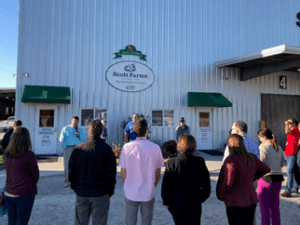
By Leslie Boney
NC State University
LUCAMA – It was a strange group of visitors looking down on the sweet potato processing line at Scott Farms one day last month.
As they listened to a plant manager talk about everything from planting to shipping, a nuclear engineer stood next to a graphic designer, a women’s studies expert next to a climatologist, each with a unique lens on what was happening. I was there with 20 recent hires at NC State as they toured eastern North Carolina, getting to know their new home state.
The sweet potatoes didn’t exactly “roll” off the line. They’re lumpy and unpredictable, so turning them from dirt-covered roots into valuable products takes a lot of planning and skill. A lot of challenges in North Carolina seem that way right now — they surface from underground raw and rooted, in need of thoughtful processing. And as with the sweet potatoes, our universities can play a key role in thinking through how to turn raw potential into real opportunity.
That requires being there from the beginning. You don’t grow a good crop just by showing up on harvest day, and you don’t address deep community challenges by turning up when it’s time to cut a ribbon or issue a news release.
In the foreword to a new book, Land Grant Universities of the Future, Peter McGrath suggests that “our nation’s communities – rural, urban, and in between – urgently need to partner as equals with the land grant universities so that together they can work on solutions to the problems of their communities.”
There’s no universal approach to the very different circumstances across North Carolina, just as there’s no single ‘correct’ way to grow a potato. It depends on the place, the conditions, the resources you have available.
That’s why effective university work comes from joining as equal partners with towns, counties, and local organizations. Cooperative extension agents and ag research stations have known this for decades: Crop research is done in dialogue with real people, not in abstract theory.
Throughout our tour of eastern North Carolina, we were reminded that the same principles apply in other sectors.
It’s one thing for design faculty to talk about a grand theory of community-centered design; it’s another to be in the middle of tense public meetings as the people of Princeville work to rebuild the nation’s oldest African-American incorporated town after yet another flood.
It’s easy for an education researcher to describe the general challenge of leading a high-poverty, hard-to-staff, low-performing school; designing effective programs for a particular principal at a particular school is much tougher.
Closing that gap between theory and practice creates amazing opportunities for learning. Entrepreneurship, industrial design, service delivery and disaster communication come alive when they’re tested in a real-world setting. That’s why universities are hands-on partners, not parachuting saviors. The work is shared, and the benefits are mutual.
We watched those Wilson County sweet potatoes get sorted, boxed, and shipped out, destined for dinner tables all over the world. We all returned to our offices and classrooms to teach and work on some of the grand challenges facing the globe: Population growth and loss; waste disposal; aging and diversifying populations; growing income inequality and persistent poverty; skilled worker shortages.
But all of us know that those “global” issues are being hashed out right here in our cities and towns, where higher ed expertise meets homegrown ingenuity. Good farmers – and good professors – need a little dirt under their fingernails.
Leslie Boney is Vice Provost for Outreach and Engagement and Director of the Institute for Emerging Issues at NC State University.

Leave a Reply